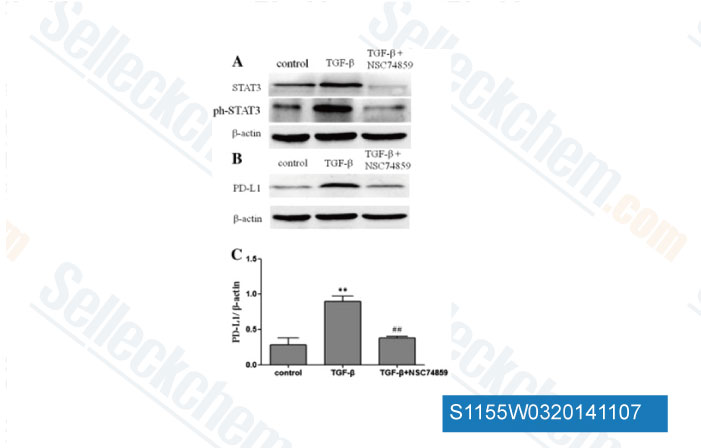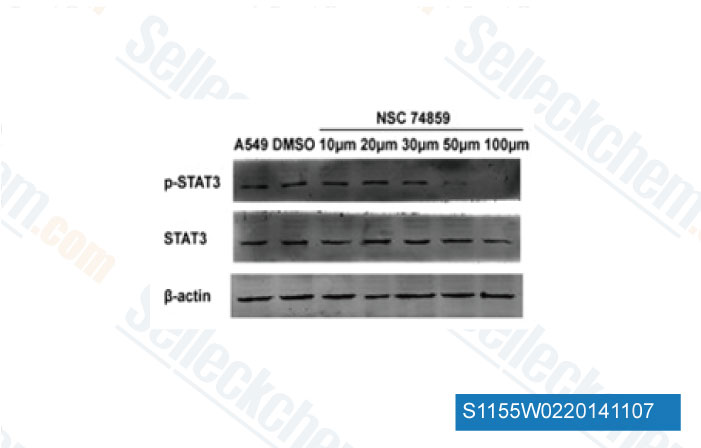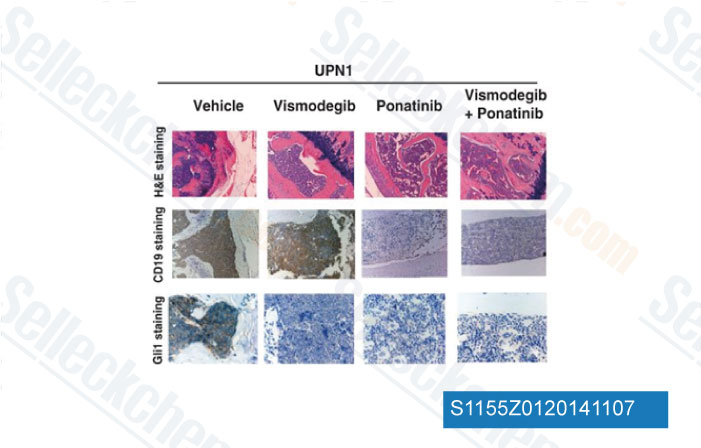|
Toll Free: (877) 796-6397 -- USA and Canada only -- |
Fax: +1-832-582-8590 Orders: +1-832-582-8158 |
Tech Support: +1-832-582-8158 Ext:3 Please provide your Order Number in the email. |
Technical Data
| Formula | C16H15NO7S |
|||
| Molecular Weight | 365.36 | CAS No. | 501919-59-1 | |
| Solubility (25°C)* | In vitro | DMSO | 73 mg/mL (199.8 mM) | |
| Water | Insoluble | |||
| Ethanol | Insoluble | |||
|
* <1 mg/ml means slightly soluble or insoluble. * Please note that Selleck tests the solubility of all compounds in-house, and the actual solubility may differ slightly from published values. This is normal and is due to slight batch-to-batch variations. * Room temperature shipping (Stability testing shows this product can be shipped without any cooling measures.) |
||||
Preparing Stock Solutions
Biological Activity
| Description | NSC 74859 (S3I-201) shows potent inhibition of STAT3 DNA-binding activity with IC50 of 86 μM in cell-free assays, and low activity towards STAT1 and STAT5. | ||
|---|---|---|---|
| Targets |
|
||
| In vitro | S3I-201 inhibits growth and induces apoptosis preferentially in tumor cells that contain persistently activated Stat3 by inhibiting Stat3·Stat3 complex formation and Stat3 DNA-binding and transcriptional activitie. Moreover, S3I-201 also inhibits the expression of the Stat3-regulated genes encoding cyclin D1, Bcl-xL, and survivin. [1] S3I-201 inhibits breast carcinoma MDA-MB-435, MDA-MB-453 and MDA-MB-231 cell lines with IC50 of 100 μM. In addition, the cells with impaired TGF-β signaling are four times as sensitive to the STAT3 inhibitor S3I-201. [2] A recent study shows that S3I-201 potentiates the antiproliferative effect in HepG2 and Huh-7 cells via the STAT3 signalling pathway. [3] |
||
| In vivo | S3I-201 (5 mg/kg, i.v. every 2 or every 3 days) shows the antitumor efficacy in mouse models with human breast tumor xenografts that harbor constitutively active Stat3. [1] S3I-201 treatment reduces Varicella-zoster virus (VZV) replication on the basis of the bioluminescence signal and the number of positive skin xenografts compared with DMSO-treated mice by inhibiting STAT3 phosphorylation. [4] |
||
| Features | A chemical probe inhibitor of Stat3 activity. |
Protocol (from reference)
| Kinase Assay: |
|
|---|---|
| Cell Assay: |
|
| Animal Study: |
|
References
Customer Product Validation

-
Data from [Data independently produced by Mol Cancer, 2014, 13:176]

-
Data from [Data independently produced by Int Immunopharmacol, 2014, 20(1), 117-23]

-
Data from [Data independently produced by Microbes Infect, 2014, 16(1), 17-27]

-
Data from [Data independently produced by Clin Cancer Res, 2013, 19(6), 1422-32]
Selleck's NSC 74859 (S3I-201) has been cited by 247 publications
| KLHL25-ACLY module functions as a switch in the fate determination of the differentiation of iTreg/Th17 [ Commun Biol, 2025, 8(1):471] | PubMed: 40119138 |
| Suberosin attenuates rheumatoid arthritis by repolarizing macrophages and inhibiting synovitis via the JAK/STAT signaling pathway [ Arthritis Res Ther, 2025, 27(1):12] | PubMed: 39838477 |
| Regulation of keratinocyte barrier function and inflammatory response by the EGFR-STAT3 Pathway: Potential therapeutic implications of osimertinib and afatinib [ Cytokine, 2025, 185:156802] | PubMed: 39612655 |
| Effect of Anti-S100A4 Monoclonal Antibody Treatment on Experimental Skin Fibrosis and Systemic Sclerosis-Specific Transcriptional Signatures in Human Skin [ Arthritis Rheumatol, 2024, 76(5):783-795] | PubMed: 38108109 |
| Augmented ERO1α upon mTORC1 activation induces ferroptosis resistance and tumor progression via upregulation of SLC7A11 [ J Exp Clin Cancer Res, 2024, 43(1):112] | PubMed: 38610018 |
| METTL8 links mt-tRNA m3C modification to the HIF1α/RTK/Akt axis to sustain GBM stemness and tumorigenicity [ Cell Death Dis, 2024, 15(5):338] | PubMed: 38744809 |
| The dual role of glucocorticoid regeneration in inflammation at parturition [ Front Immunol, 2024, 15:1459489] | PubMed: 39290694 |
| Airway Basal Stem Cells in COVID-19 Exhibit a Proinflammatory Signature and Impaired Mucocililary Differentiation [ Am J Respir Cell Mol Biol, 2024, 70(1):26-38] | PubMed: 37699145 |
| Ruxolitinib improves the inflammatory microenvironment, restores glutamate homeostasis, and promotes functional recovery after spinal cord injury [ Neural Regen Res, 2024, 19(11):2499-2512] | PubMed: 38526286 |
| p38α deficiency ameliorates psoriasis development by downregulating STAT3-mediated keratinocyte proliferation and cytokine production [ Commun Biol, 2024, 7(1):999] | PubMed: 39147860 |
RETURN POLICY
Selleck Chemical’s Unconditional Return Policy ensures a smooth online shopping experience for our customers. If you are in any way unsatisfied with your purchase, you may return any item(s) within 7 days of receiving it. In the event of product quality issues, either protocol related or product related problems, you may return any item(s) within 365 days from the original purchase date. Please follow the instructions below when returning products.
SHIPPING AND STORAGE
Selleck products are transported at room temperature. If you receive the product at room temperature, please rest assured, the Selleck Quality Inspection Department has conducted experiments to verify that the normal temperature placement of one month will not affect the biological activity of powder products. After collecting, please store the product according to the requirements described in the datasheet. Most Selleck products are stable under the recommended conditions.
NOT FOR HUMAN, VETERINARY DIAGNOSTIC OR THERAPEUTIC USE.
